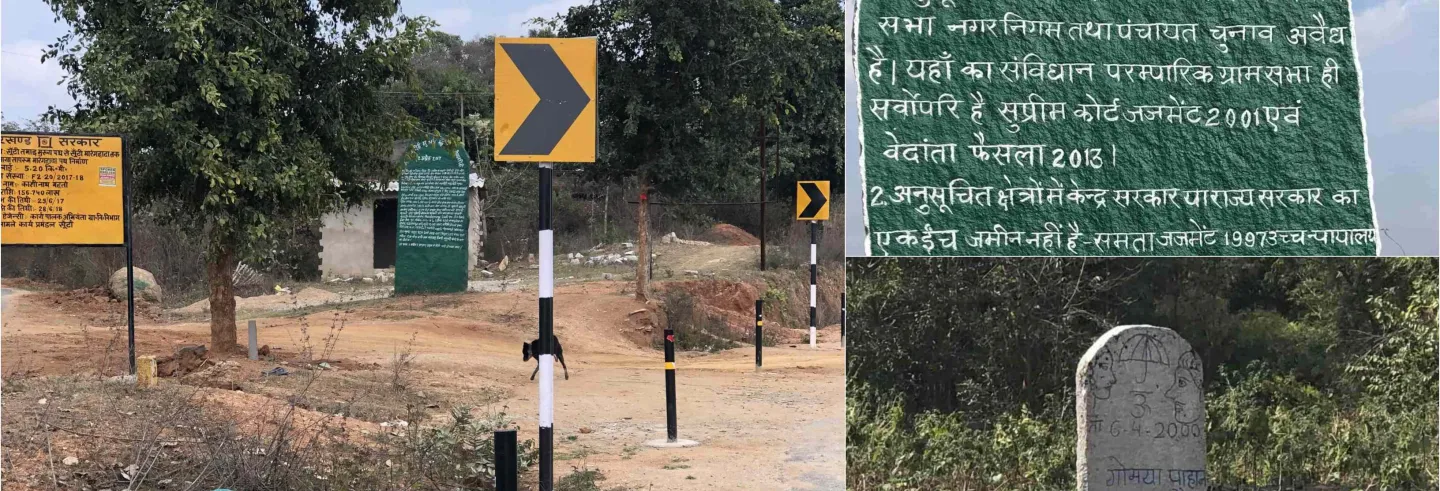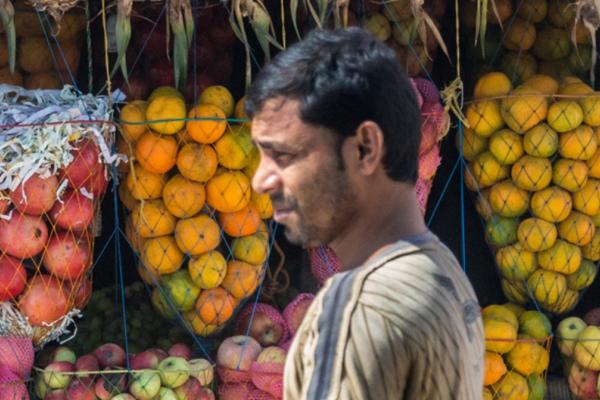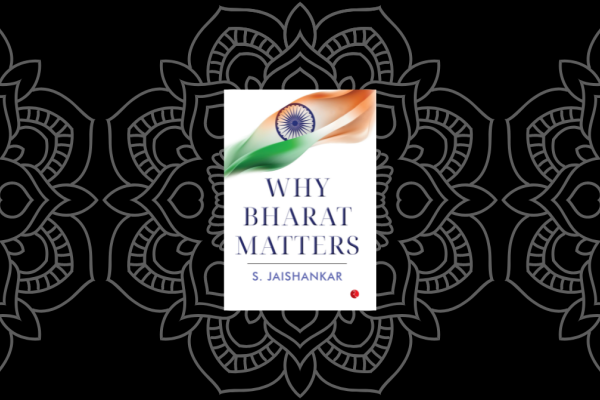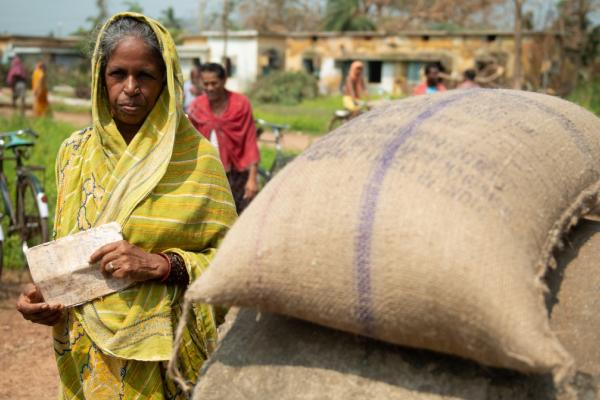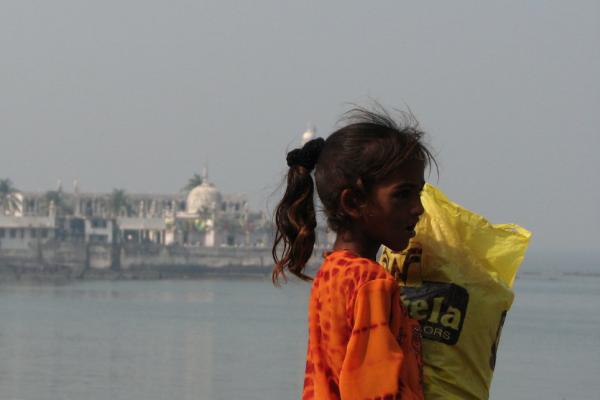In December 2019, in elections to the Jharkhand Assembly, a coalition of parties under the leadership of the Jharkhand Mukti Morcha (JMM) party won, defeating the incumbent Bharatiya Janata Party (BJP)-led government led by Raghubar Das. The very first decision taken by the new chief minister, Hemant Soren, was to withdraw all the cases registered against the protestors involved in the Pathalgadi movement against the previous government’s amendment of the special laws that protected tribal rights to land. The withdrawal was a small victory and brought an important phase of the Pathalgadi movement to a resolution.
This was a moment in India’s political history when electoral change brought gains for a social movement. Such electoral victories for relatively localised social movements, especially against land dispossession, are a rare phenomenon in Indian politics. In the case of Jharkhand, previous writing has drawn attention to the distinctions that Munda communities hold between the state, democratic processes, and politics; and how elections are sometimes used to ‘keep the state away’ (Shah 2007).The history of politics in this region also demonstrates that Adivasi communities have always utilised multiple pathways into the electoral system, shifting allegiances across political parties strategically. 1 This piece on the May 2014 elections provides one such example: https://indianexpress.com/article/india/politics/maoists-in-jharkhand-eye-new-future-through-electoral-democracy/ In December 2019, a confluence of issues, prior mobilisation, the momentum of a two-year-old social movement, and the scale of the state assembly contest produced another iteration of the relationship between the state, elections, and the Constitution of India that takes our understanding of contemporary politics further.
The green pathals of the Pathalgadi movement brought the physical and conceptual margins of the village together by erecting giant pathals which acted as a bulwark against the polluting influence of the state.
In these elections to the Vidhan Sabha, a range of phenomena of critical significance to the ideas of democracy and development were put to test, as the issue of land dispossession amongst Adivasis became intertwined with broader issues of citizenship and self-government. An interface between customary law and constitutionalism, potent symbolism drawn from local social practices, and an assertion of indigenous rights through electoral politics were all in evidence. To understand this unique moment, we will draw on existing literature on Jharkhand, election data, anthropological understandings of symbols, and our own field visit in February 2020 to Khunti district—the ‘epicentre’ of the movement—to make a case for cultural moorings of democratic action 2 In particular, see Tiwary 2018, Singh 2019 and Xaxa 2019 on the Pathalgadi movement. .
The Pathalgadi Movement: Background
The Pathalgadi movement began sometime in the middle of 2017, when giant green slabs of stone (pathals), about 15 feet tall and 4 feet wide, with inscriptions from the Constitution began to appear at the entrance to Munda villages in Khunti, and later in other districts in Jharkhand.
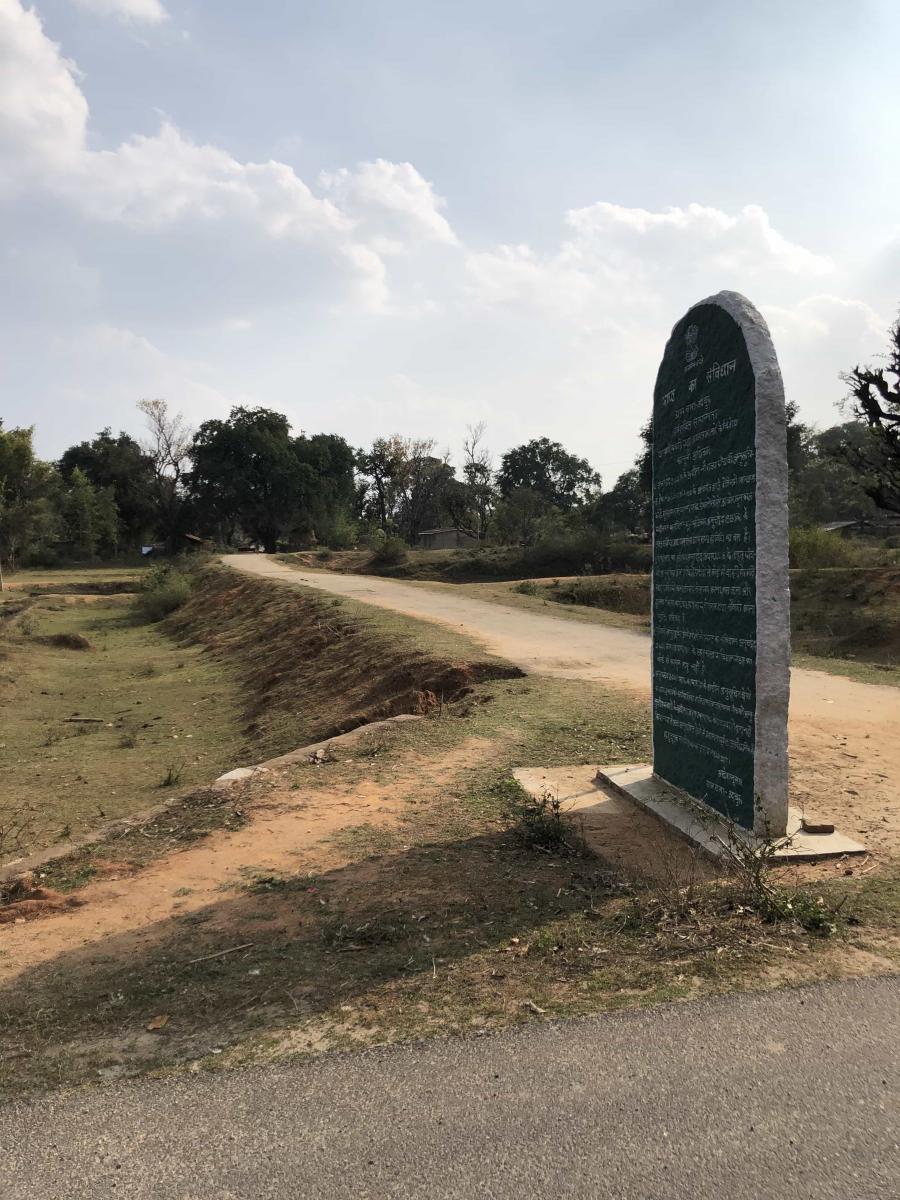
On many occasions the local administration was informed about the installation of the pathal, and on some occasions, these rituals were attended by the district collector and police officials. The pathals reproduced specific provisions of the Constitution, relevant for governance of tribal areas: the Fifth Schedule that granted special rights to Adivasi communities, Article 13 (3) (a) that validates traditional and customary rights of Adivasis to their land and resources, Article 244 (1) that deals with administration of the Scheduled Areas and Tribal Areas of India, and the provisions of the Panchayat Extension to Scheduled Areas (PESA) Act 1996. These stone slabs drew on the Mundari custom of erecting pathals to record deaths, Mundari history, and land ownership. The novelty of their use on this occasion was the inscription of provisions from the Constitution of India to record their protest against the state government that was seen to violate the sanctity of land and the rights of the Munda.
Specific events had triggered the installation of the pathals. In November 2016, amendments to the 1908 Chotanagpur Tenancy Act (CNTA) and the 1949 Santhal Pargana Tenancy Act (SPTA), were passed by the ruling government in the state assembly. Both the CNTA and SPTA were colonial laws that had upheld tribal rights in land and recognised customary village institutions 3 See Sundar (2005) for a history of legislations and an anthropologically nuanced account of the complexity of the category of ‘custom’ in discussions of ‘customary self-government’. . The new legislation amended the CNTA such that land belonging to Adivasis could be acquired for a variety of ends such as mining, industry, railways and construction of buildings.
The manner in which amendments to these laws were passed in the Jharkhand Assembly suggested subterfuge. The passage of the bill making these amendments, giving legislative sanction to an ordinance issued in May 2016, took a mere three minutes, disallowing any discussion of opposing views from not just members of the opposition parties—the JMM, the Jharkhand Vikas Morcha (JVM), and the Congress party — but also by members of the ruling BJP. Important leaders of the ruling party such as former chief minister Arjun Munda and former Lok Sabha deputy speaker Karia Munda were opposed to the bill in principle.4 Kariya Munda is regarded as one of the stalwarts of the Bharatiya Jan Sangh in Jharkhand; he has represented Khunti 8 times as a Member of Parliament and has also served as a cabinet minister. The then parliamentary affairs minister Saryu Ray, also of the BJP, later told us in an interview that even though his ministerial office made him responsible for the business of the house, he was not informed in advance of the tabling of these amendment bills. It became evident to many that Chief Minister Raghubar Das was pushing through legislation without consulting colleagues in his party and acting perhaps at the behest of interests beyond the state of Jharkhand.
The Pathalgadi protests were provoked by this bill that was perceived as an assault on the statutory powers assigned to the gram sabhas. Under the PESA Act brought in the 1990s, power had been devolved to the gram sabhas which could act through "customary tradition" and approve development plans and projects in their area in accordance with traditional practices of management of community resources. In bypassing the gram sabhas, the new law effectively treated the Adivasis as subordinate subjects rather than active citizens who had been empowered to make decisions about the use of resources through collective deliberation. This confirmed an "Munda cultural imaginings of the state"(Shah 2007, 142). 5 Shah (2007) is based on fieldwork at the time of the formation of the new state of Jharkhand, and predominantly in non-Christian Munda areas. Her later work discusses an evolving relationship with the state and a comparison between Christian and non-Christian areas. In such an imagination, the state represented a politics of self-interest, of "exploitation" (soshan) and a "destructive force of socially divisive goods" (Shah 2007, 135, 136). The pathals with inscriptions of PESA were erected as a reassertion of the constitutional sovereignty of the Munda and capacity for self-government.
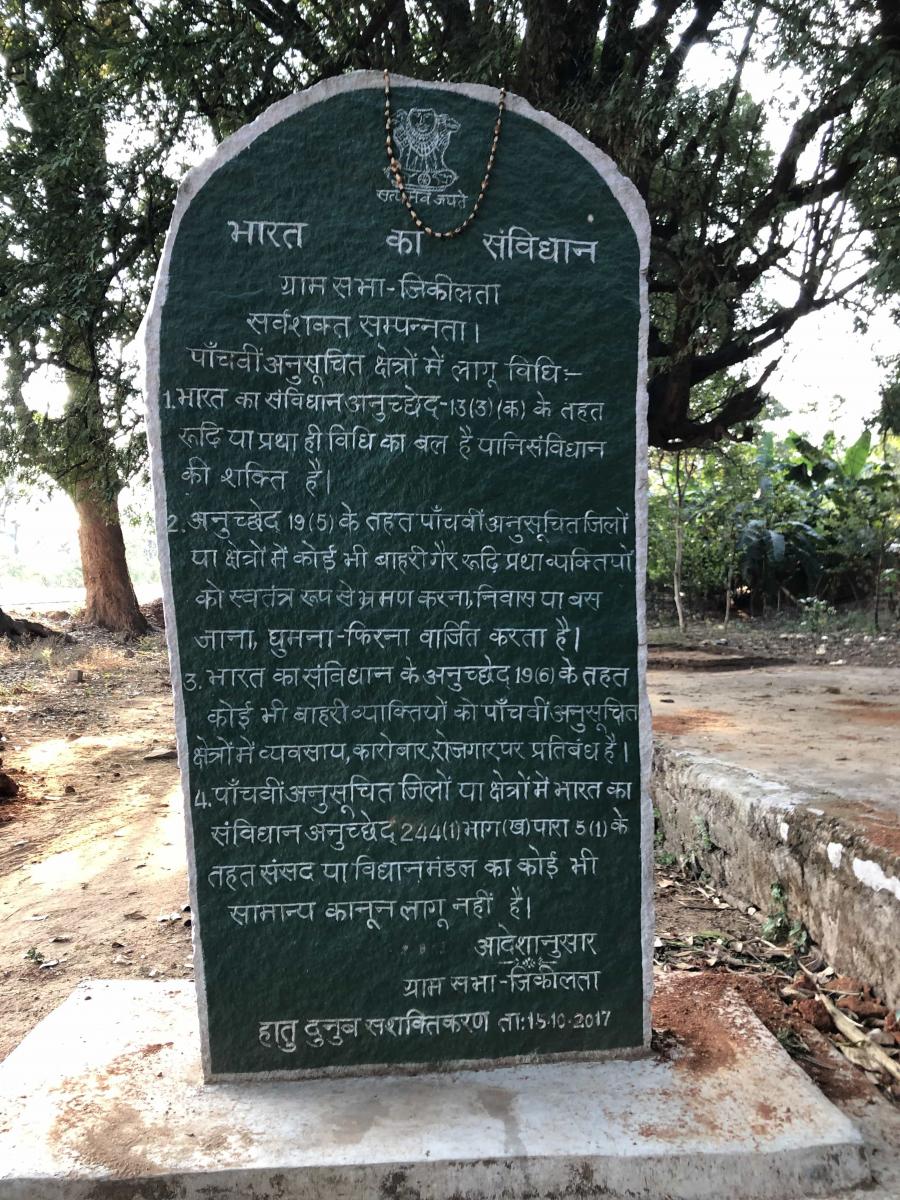
It is important to remember that Jharkhand had been carved out from the larger state of Bihar in 2000, reinforcing its identity as an ‘Adivasi state’. From 2000 to 2014, all of its chief ministers had belonged to various tribal communities. This changed after the assembly elections in 2014, when a coalition led by the BJP decided to do away with the commitment to tribal leadership and Raghubar Das was made the first non-tribal chief minister of Jharkhand. The underlying political logic was that as the tribal population made up less than a third of the total population, a larger caste Hindu mobilisation (assumed to make up the natural support base of the BJP) could marginalise tribal interests and make it easier to weaken the hold of special institutions and laws protecting tribal rights in land.
The CNT and the SPTA, which guaranteed customary tribal rights in land and a role for village level gram sabhas under PESA, were clearly a thorn in the side of the new government’s ambitions for ‘development’. The non-tribal chief minister Raghubar Das was expected to hasten a ‘development agenda’ aimed at attracting big capital and investments into a state rich in minerals and natural resources. 6 While people we met in our field work named particular big industrialists as interested in acquiring tribal land for their mega projects and driving the amendments to CNTA and SPTA, we are concerned here with the intentions of the state in its industrial policy. The 2016 Industrial and Investment Promotion Policy draft drawn up alongside the adoption of the amendments to the two laws, sought to make the state safe for big investments and guaranteed easy access to land for industrial and mining purposes. The usual mechanisms of industrial parks, land banks, and special export zones, familiar from elsewhere in India, were now planned for Jharkhand.
But Jharkhand has a long history of popular mobilisations against the claims of the state. The CNT Act itself was an outcome of the Birsa revolt centered in Khunti against the British Raj, and this time, too, the protests against arbitrary state legislation, began in Khunti. In October 2016, people collected in Soyko, Khunti district, to protest the May ordinance and planned a protest march to the state capital, Ranchi. But the state, alert to the possibility of protests, acted with alacrity. Police rushed to prevent the gathering by opening fire, killing a young boy Abraham Soy, and injuring two others. Protestors immediately gheraoed an officer and his bodyguard from the Murhu police station and held the two bodyguards of BJP tribal leader Karia Munda.
In retaliation, the search parties of the police forcibly entered Munda villages. One unprovoked physical assault on a Munda pradhan, in a manner that has become routine police conduct, proved to be the tipping point. This was a direct violation of PESA 1996’s recognition of the gram sabha and the sovereignty of its membership. As a result of this assault on the president of the gram sabha and the thwarting of attempts to have a civil conversation with officials, Munda communities took the decision to erect pathals to forbid the entry of all state functionaries into their villages without the express permission from the pradhan of the gram sabha. Over the course of the next year, nearly 200 villages in Khunti district—both Christian and non-Christian—erected the stones and proclaimed the gram sabha to be their only legitimate institution. "If we cannot protest about our rights violation, and if we are not allowed to march to Ranchi, we will retaliate by preventing the entry of all arms of the state from our village community," was the message. We were told by teachers and others that parents stopped sending their children to school and did not visit primary health centres and returned Aaadhar and MGNREGA job cards—papers of the state—to the block development officer (BDO). 7 Shah recorded that the BDOs were particularly reviled by the Munda as they were ‘seen to disguise their destructive capacity in a language of ‘acting in the interest of the poor’ (Shah 2007:15).
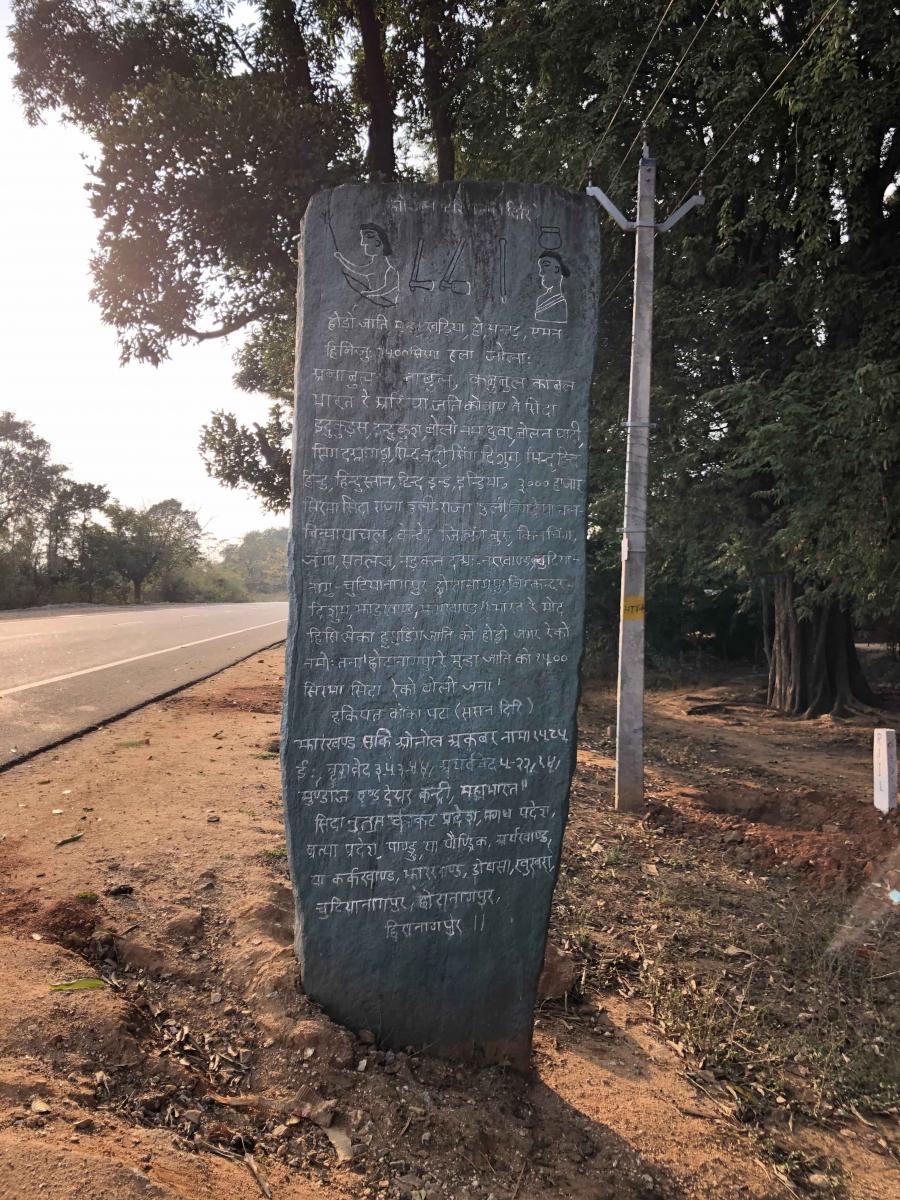
A new leadership for the movement emerged, of whom the most well-known were Belosa Babita Kacchap, Vijay Kujur and Krishna Hansda. These young leaders were able to take the issue to a wider community of Adivasis in the neighbouring states of Chattisgarh and Orissa that were also covered by the Fifth Schedule. There, Bhil and Gond tribal leaders made common cause with the Pathalgadi movement on issues of land dispossession and the threatened sovereignty of gram sabhas. Soon the demands of the movement went beyond simply asking for the roll back of the amendments to CNTA and SPTA and extended to demands for constitution of their own education board, greater use of Mundari as a lingua franca, and increased self-determination.
The state responded with classic ham-fisted techniques, emboldened further by the return of the ruling party to national government in May 2019. The Jharkhand government slapped criminal charges and recorded First Information Reports (FIRs) against over 10,000 people. Attempts were made to infiltrate and discredit the Pathalgadi movement by spreading rumours about the hidden hand of Maoists or Christian missionaries and by planting divisive stories of an Oraon takeover of Munda politics (Both Kacchap and Kujur are Oraon). There were attempts at further vilification of the movement through claims that the assertion of autonomy of the gram sabha was in effect a cover for continuing illegal farming of opium in Khunti villages.
But it was increasingly evident that the collective mobilisation of the Pathalgadi movement was built on prior political work done around the demands for PESA in the 1990s. Tribal rights activist, politician, and former Indian Police Service officer Bandi Oraon, told us how the PESA movements had educated a younger generation about the customary law of Adivasis, capturing their imagination through the erection of pathals with inscriptions. Leading tribal rights activists like Oraon and former Indian Administrative Service officer B D Sharma had led the PESA awareness drives across not just Jharkhand but also among tribal communities in Rajasthan, Maharashtra, and Chhattisgarh.
The Jharkhand Pathalgadi movement in 2016–17 could therefore build on an existing awareness of issues and was able to find support among a wide community of Adivasis who lived in the Fifth Schedule areas. As before, this time too, they used the practice of inscribing select text of the Constitution on giant slabs of stone.
Written in stone
The tradition of erecting pathals is a long-standing one in Munda society. Such pathals were traditionally part of sasandiri, the practice of engraving the name of the deceased on a stone erected by the grave. With every fresh burial, the name of the newly dead family member was added to the stone. Writing in stone as record keeping had other uses too. For instance, we were told how the story of a young couple who violated the strict rules of village exogamy and had to be expelled from the village. Their names were inscribed on a stone and set in the middle of the village as a reminder to all future lovers about the dangers of social transgressions. We also found stones, the same size as the political pathals, inscribed with a history of the Munda community in Khunti district.
It was evident therefore that the use of stone inscriptions was not invented in the 1990s or in 2017. Rather, they were part of the cultural repertoire of record keeping and proclamation. The traces of the earlier PESA agitation from the 1990s in Munda villages were to be found even in 2020, when older faded pathals that had reproduced the Fifth Schedule of the Constitution in great detail, continued to stand.
We also saw extracts from the Fifth Schedule painted on the walls of pucca buildings within the villages, their faded colours indicating that they had been around for some years. Written in Mundari, these inscriptions served several purposes. Activists had been able to communicate the contents of the special provisions of the Fifth Schedule in the local language. The use of Mundari had also served as an act of self-assertion of the language and identity of the community. Their visible presence across the landscape served to create a constant awareness of the Fifth Schedule and the growing mobilisation around it. During the Pathalgadi agitation, some of these older stones had clearly been used: fresh writing had been painted over older lettering.
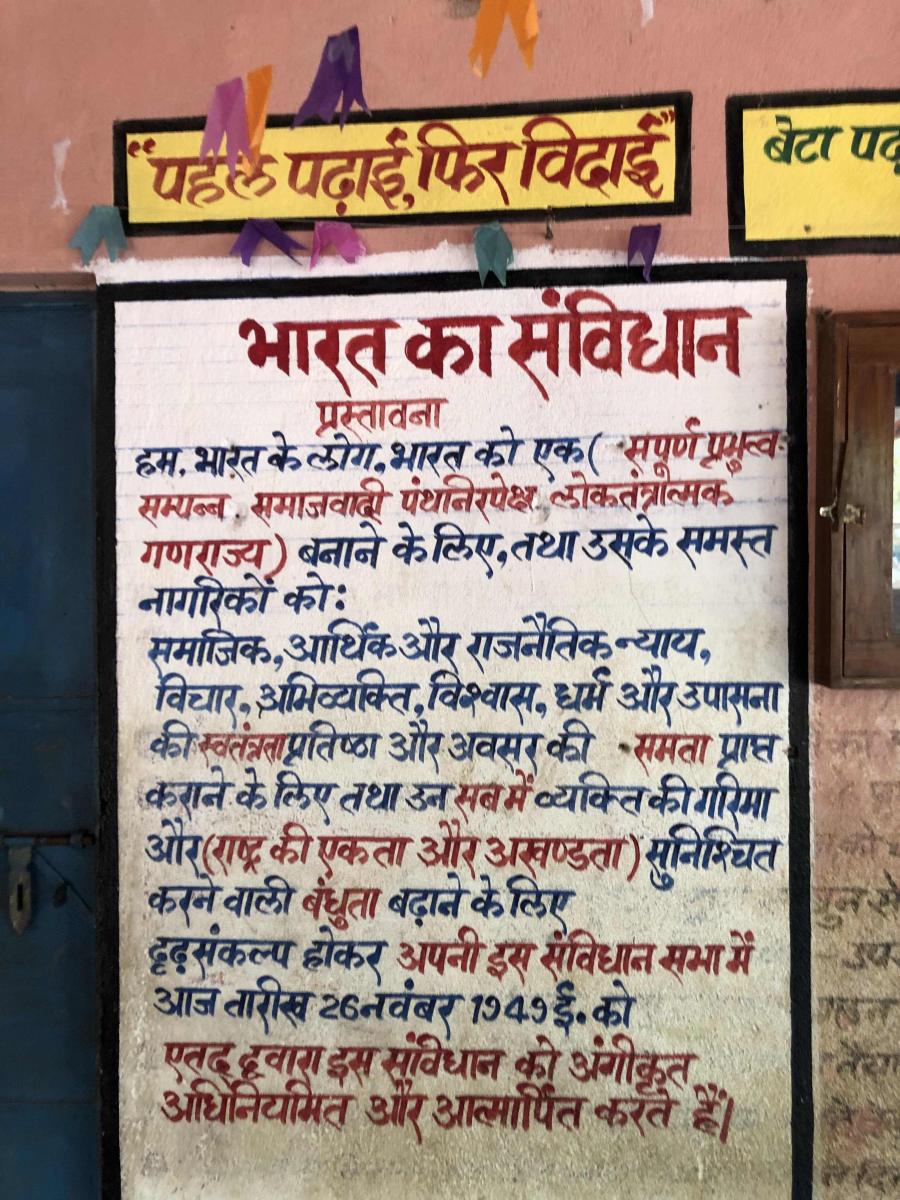
As the images show, in these more recent iterations, the language used was Hindi, which indicated that this time the evocation of the Fifth Schedule was intended also as a reminder to the Jharkhand government that they intended to use the special provisions that were constitutionally available to Munda society to their advantage. The position of the pathals, at the entrance to the villages, and their height and words acted as sentinels guarding the villages and people within them. 8 The use of stones as boundary markers (tydudiri ) also had older resonances in Munda society, not through inscription but through aggregation. We were told by a middle-aged school teacher that he could remember that in his childhood revenue boundaries of villages were marked by a pile of stones. It was customary for anyone walking past such a heap to pick up a couple of others and add to it. And thus the age of such a pile of stones could be estimated from its height.
Interestingly, in response, the government also evoked the Constitution, but with text from the Preamble. The words of the Preamble were freshly painted on the walls of school buildings and children were encouraged to recite it every day alongside the national anthem. The assertion here was to reiterate the opening phrase of the Preamble of the Constitution—"We, the People of India"—to create homogeneity and thereby undermine, through constitutional means, the special rights that the Pathalgadi movement had demanded. As one teacher, rehearsing the government’s message, put it to us "in the eyes of the law, everyone is the same in India, no one is too big or too small, too rich or too poor, we are all the same." While this is indeed the progressive assertion of the Constitution (used to great effect by the anti-Citizenship Amendment Act protests across India from December 2019–March 2020), in the context of the politics of this part of India, it was intended to undercut the legitimacy of the Pathalgadi movement.
In the run up to the December 2019 elections, therefore, the following messages had been communicated and shared by all. First, the pathals marked village boundaries, within which the gram sabha was asserted as a legitimate locus of local governance. Second, the pathals were intended to act as a mirror to the actions of the state legislature that had acted against the spirit of the Constitution to pass legislation that so evidently violated the provisions of the Fifth Schedule. Third, the collective mobilisation around the Pathalgadi movement called into question the paradigm of development itself, one that alienated people from their land and granted their use to large corporate interests. The movement successfully articulated not just a case for indigenous Adivasi rights, but did so by evoking the Constitution and its provisions in support of their cause, making it a "people’s constitution" (De 2018).
Fourth, the established use of Pathalgadi reflected a wider engagement with law, whereby the customary practice of announcing laws through inscriptions on stone (hukumdiri) and then remembered ritually thereafter made them potent symbols. This practice continued into the present as, people gathered at the giant pathals each Thursday to recommit themselves to their struggle for their constitutional rights. And, finally, practices of boundary maintenance, as we saw on our travels, echoed a wider repertoire of practices against the spread of disease and contagion in in Munda villages. At the end of the rainy season every year, a woman from each household carries with her a small collection of items—a used broom, an earthen pot, a winnowing basket, some vermilion. They then walk to the boundary and after puja to the village deity (usually a tree) deposit the items on the other side of the village perimeter. Having rid these objects of contagion from the village the women reenter the village only after they have had a purifying bath.
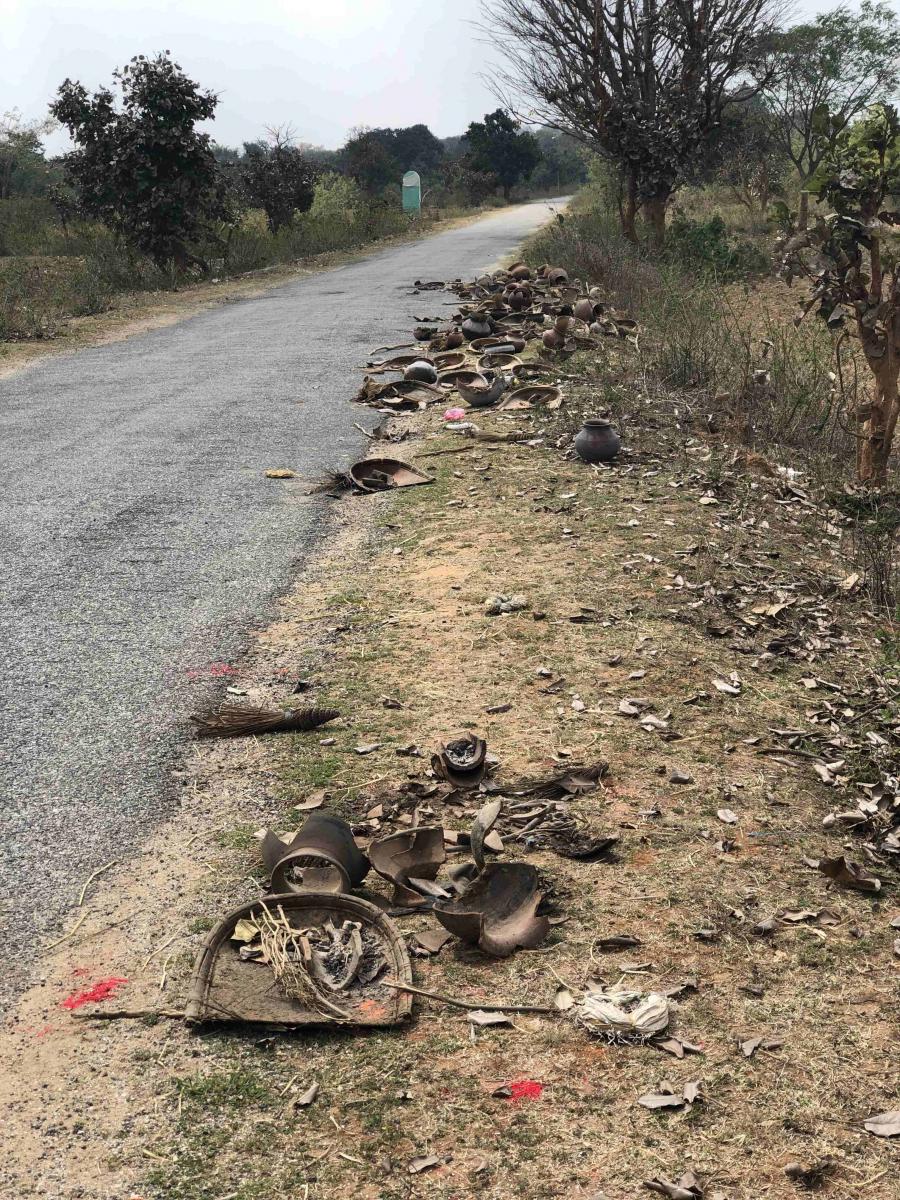
The notion of keeping contagion outside the boundary of the village was thus an established norm in Munda villages. The use of the pathals to keep the state out during the Pathalgadi movement can be read as an analogous practice. As the image above shows, the pathals stand near the discarded items and indicate that the village boundaries beyond which both contagion and ‘external’ government were expelled, were the same. 9 That the local administration and police were informed before Pathalgadi in village Bhandra and attended by the DC and local thana in-charge, makes it evident that this was not a straightforward ‘anti-state’ protest at the start. But it was when the state resorted to its usual repression, confirming Munda conceptions of the state, that this changed. (See https://drive.google.com/open?id=1wImHv8kXRi7VJlXj9Kz0uuVrTwAaUM for reports by PUCL, Adiwasi Adhikar Manch, Women Against Sexual Violence)
What, we may ask, did the Pathalgadi movement achieve in the run up to the elections in December 2019? It was evident that the collective mobilisation against state laws forged a rare unity amongst various tribal groups, social organisations, and non-BJP political parties on the issues raised by the Pathalgadi movement. Within the Adivasis the divisions between the Christian and the Sarana tribal communities were put aside to protest against acquisition of tribal land and over 200 representations were sent to the Jharkhand governor, Draupadi Murmu, whose approval was needed for all laws related to Scheduled Areas. The requests were for her to withhold her assent to the new law that had been bulldozed through the Vidhan Sabha. She did, in fact, return the legislation to the government for reconsideration.
The second significant outcome was that the Pathalgadi movement gave the electoral coalition of opposition parties a substantive agenda. The slogan of Jal, Jangal, aur Jameen (‘Water, Forest, and Land’) focused attention on customary rights of indigenous Adivasi communities over their land and natural resources. Promises of distant and speculative neo-liberal industrial development put forward by the national and state governments were shown to be hollow, and in complete violation of constitutionally mandated notions of local democracy and rights. The disregard for these issues by the Raghubar Das administration focused the anger of voters against the incumbent government.
The election manifesto of the JMM—called the Nischay Patra ('Definite Promise')—became an explicit statement of a new vision for Jharkhand. Their promise was to bring about a law to affirm people’s rights in land (Bhumi Adhikaar Kanoon), and to provide land to the landless. There were other promises too for educated unemployed youth as well as students in local colleges where the new cadre of leaders of the Pathalgadi movement studied. Further, the manifesto offered the option of a democratic government that would work for the people of the state (by implication not the central government) and promised to "strengthen and enrich the land of Jharkhand" (Jharkhand ki mati ko samriddh karega).
There were two distinct aspects of how the JMM manifesto set the agenda for the assembly elections in November–December 2019.
First, although the JMM was in a pre-poll alliance with the Congress party and the RJD, it was the JMM’s Nishchay Patra and the rights of Adivasis that dominated the campaign. This attracted smaller social organisations such as the Jharkhand Janadhikar Manch, which fought for people’s rights but had hitherto kept its distance from electoral politics, to lend implicit support to this pro-adivasi electoral agenda. Activists like Dayamani Barla from smaller regional parties such as the JVM fought in the Khunti assembly constituency against the BJP.
Second, the BJP’s campaign in contrast fought the state elections as an extension of the centre—‘Double Engine ki Sarkar’—as it said on the posters and that were illustrated with photographs of Chief Minister Raghubar Das and Prime Minister Narendra Modi. Local leaders and issues were absent from the campaign and the prime minister campaigned extensively across the state including in the constituency of Raghubar Das. The BJP campaign rehearsed messages from their parliamentary election campaign of May 2019 and did not bother to embed them in local issues, or engage with the issue of Adivasi rights, the demands of the Pathalgadi movement, and their critique of extractive industries. The cookie cutter campaign of the BJP and of Narendra Modi, national schemes, and a hubristic assertion of an assured win of 65 out of 81 seats (abki bar paisath paar) marked the difference between the two electoral options for voters.
In the end, the BJP won only 25 seats and the JMM-led coalition emerged victorious with 47 seats. The chief minister lost in his own constituency, defeated by his former colleague, Saryu Ray, who had resigned and stood as an independent candidate after being bypassed in the passage of the controversial bill. Significantly for the Pathalgadi movement, out of the 28 reserved seats for the Scheduled Tribe (ST) dominated constituencies, the JMM coalition won a substantial 22 seats and the BJP only two.
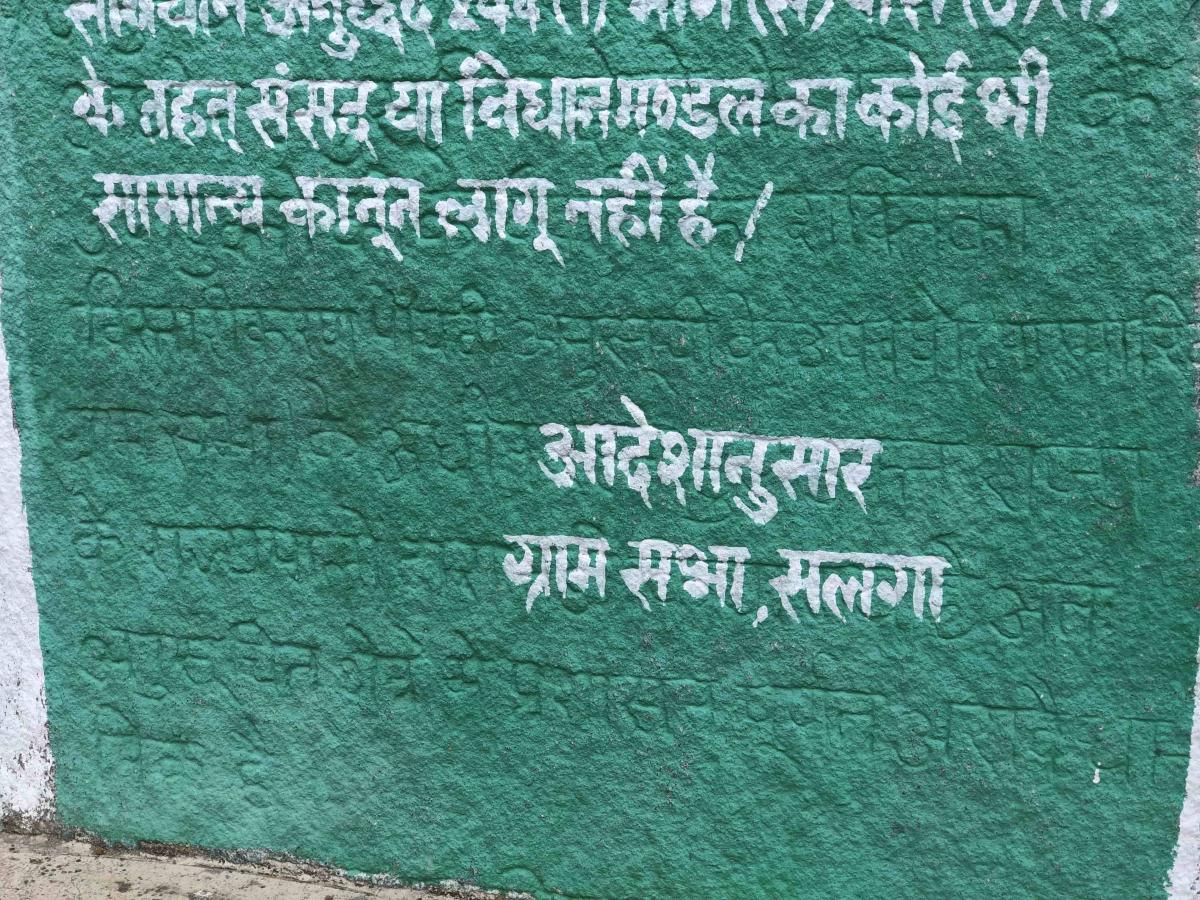
In a curious twist, both the seats won by the BJP were in Khunti district, the epicentre of the Pathalgadi movement. CSDS Lokniti surveys conducted after polling day asked respondents about their knowledge of Pathalgadi and whether they believed that the issues raised by the movement were correct. In the two Khunti assembly constituencies (Khunti and Torpa), 50% of the ST voters knew about Pathalgadi and 48% considered the issues raised by the movement to be right.
So why did they vote for the BJP? One plausible explanation is that votes were used strategically to reassert Munda dominance, especially as Munda candidates had to face shenanigans within the BJP. In the 2019 national elections, BJP’s long-standing MP, octogenarian Karia Munda, was denied a ticket. Instead, Arjun Munda was given the ticket, in the anticipation that the Pathalgadi backlash would cause his defeat. Arjun had been an opponent of the CNTA amendment and of Raghubar Das and this was to be his punishment. Arjun fought the elections without his party’s support and won with a narrow margin. In the subsequent state assembly elections in December, Nilkanth Singh Munda was re-elected as MLA from the BJP and Karia Munda’s son left the BJP to join the JMM after his father’s humiliation and being denied a ticket himself. Thus, while on paper the results indicate BJP wins in Khunti district despite the strength of the Pathalgadi movement there, the reality was a lot more complex.
The vote for Arjun Munda could not be read as a vote for the BJP, but instead as a reward for his opposition to amendment bill. In December he had also supported Saryu Rai’s successful electoral campaign against the chief minister. The story from the ground tells us that when faced with a choice of political parties on the ballot paper, voters chose to vote for the candidate who was committed to safeguarding their rights, regardless of their formal party affiliation.
Conclusions
Reflecting on the existing scholarship on this issue, reports from fact-finding committees of civil society organisations, media reports, and our own research, we suggest that the Pathalgadi movement can be productively read as an account of the effective use of margins and marginality in wider democratic practice. These communities, like other tribal communities have historically occupied a position of marginality in national discourses of development and legislations such as PESA and the Fifth Schedule that sought to redress this marginalisation. The previous Jharkhand government’s deliberate violation of these constitutional rights and redressal had led the same tribal communities to draw a line to keep such a government out of their communities. The passage of the amendments to the CNTA and SPTA in 2016 that had dispossessed local, Adivasi, governments of the right to the determine the use of land and forests, had been proof of the then government’s desire to benefit a few interest groups.
The green pathals of the Pathalgadi movement brought the physical and conceptual margins of the village together by erecting giant pathals which acted as a bulwark against the polluting influence of the state.
The victory of Arjun Munda in the Lok Sabha and that of the two Munda candidates in the Vidhan Sabha elections in December on BJP tickets indicated that as with social movements before it, the Pathalgadi movement was catholic in its choice of a political party. The message from the voters in the elections clearly indicated that their priority was the safeguarding of Adivasi rights and they would vote for any candidate, regardless of party affiliation, who challenged a government that attempted to violate those rights. Political parties and their formal ideologies were therefore but a means to achieve their desired end. It is notable that between them, Munda leaders had strong footholds in all major parties—BJP, JMM, and even the Congress.
What was witnessed in Jharkhand during the Pathalgadi movement was an intricate interplay of constitutional rights, electoral politics, social movements, local sovereignty, and a ritual imagination of pollution...
Some studies have proposed that the Munda held two views of politics in which one was represented by a venal state and the other by the moral village-based politics of the parha (Shah 2007). 10 Please see Sundar 2013 for a critique of this view : ‘the parha is hardly a sacral polity…the whole parha system in Jharkhand has been the subject of intense debate among different shades of political activists, from indigenist NGOs who have tried to revive it in its secular form, to the Hindu chauvinist Rashtriya Swayamsevak Sangh (RSS) which has tried to promote federations of traditional headmen as bearers of an authentic adivasi culture as against a Christianised elite (Sundar 2013:366). The Pathalgadi movement demonstrates that the picture may be more complex than that, once we acknowledge the skillful engagement of tribal communities with electoral politics.
What was witnessed in Jharkhand during the Pathalgadi movement was an intricate interplay of constitutional rights, electoral politics, social movements, local sovereignty, and a ritual imagination of pollution, that were all evoked simultaneously. In this, the tactics of the Pathalgadi movement and voters were adroit and provide a good illustration of Uday Chandra’s observation that "subaltern resistance, whether violent or peaceful, is best understood as the negotiation, not negation, of modern state power" (Chandra 2013).
The future will tell if the elections of December 2019 were only the battle and not the war.
We would like to thank the following people for their help during our fieldwork in Jharkhand: Harishwar Dayal, Jean Dreze, Siraj Dutta, Rezy Dungdung, Saryu Ray, Shaival Sahay, Sanjay Kumar at Lokniti, CSDS, and the staff of ‘CINI’, and Tata Trust.


